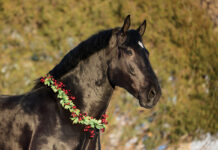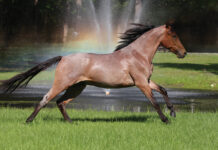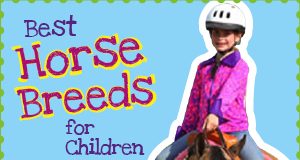
One of the oldest breeds in existence, the Norwegian Fjord is easy to recognize with its characteristic dun color, dorsal stripe, primitive markings, and flaxen mane trimmed in an upright crescent. It’s no wonder these horses have been intentionally bred for thousands of years: they are powerful, hardy, graceful and versatile; perfect for driving.
Horse: MHF Lena
About Ardeth: I started driving almost 15 years ago, and I was hooked. These days, I compete in combined and pleasure driving, and drive at home on my farm just for fun. I also use my horse and carriage to raise money for charity.
About Lena: I bought Lena 10 years ago when she was 3. I owned her dam (NFH Jayne), and when I was offered the opportunity to buy Lena, I took it.
What have been the highlights of your driving career?
We compete at CDEs at the Intermediate level. Moving up was a struggle, but meeting the challenge has been very rewarding. Every phase of the competition is more demanding, and I have had to learn about conditioning a heavily muscled pony for the longer distances and demands of the marathon.
What else do you do with Lena?
She has had training in dressage and hunter/jumpers. She is a cute jumper, trail rides and gives pony rides to children.
What is your favorite thing about the breed?
Lena is truly bombproof. I could tell story after story of times when she has stoically stood her ground in the face of scary things.
What is your best driving-related memory with Lena?
When Lena was 4 and still somewhat green, she stood in for her mother at a driving demonstration at a county fair. I thought we’d be trotting around a ring. Instead we were on a racetrack with races going on. We had to walk through a crowd of people with dogs on leashes, kids in strollers and carnival rides. It was chaos, but Lena never balked.
Why does Lena make a good driving horse?
She is very easy to train, brave and calm. Despite her quiet demeanor, she is willing to put on the speed when asked for it.
Get to know more driving breeds. Back to Driven to Succeed >>
This article originally appeared in the October 2013 issue of Horse Illustrated. Click here to subscribe!






Nice.